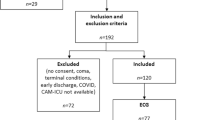Abstract
Severe brain damage may cause alterations of cardiovascular function: heart rate, particularly, require the integrity of the vagal, sympathetic and central nervous systems. We studied brain-heart functional relation and neurovegetative modulation by spectral analysis of heart rate variability (HRV). This technique allows separate evaluation of the sympathetic and vagal components of heart rate modulation.
In order to correlate changes in HRV with brain damage, we performed 45 recordings in 6 patients (5/1 M/F) by means of autoregressive analysis (AAR). All patients were admitted to the ICU for severe brain damage (anoxic, traumatic or vascular). In 4 patients clinical outcome was brain death, in 2 permanent vegetative status.
Two different patterns were found: one in patients with brain death, the other in patients with vegetative status.
The small number of patients does not allow definitive conclusions from collected data, but that application of spectral analysis of HRV seems to be a useful monitoring of brain damage subjects.
Similar content being viewed by others
References
Evans BM. Heart rate studies in association with electroencephalography (EEG) as a means of assessing the progress of head injuries. Acta Neurochir 1979; Suppl 28: 52–7.
Leipzig TJ, Lowensohn RI. Heart rate variability in neurosurgical patients. Neurosurg 1986; 19: 356–62.
Pagani M, Lombardi F, Guzzetti S, Rimoldi O, Furlan R, Pizzinelli P et al. Power spectral analysis of heart rate and arterial pressure variability as a marker of sympatho-vagal interaction in man and conscious dog. Circ Res 1986; 59: 178–93.
Zetteberg LH. Estimation of parameters for a linear difference equation with application to EEG analysis. Math Biosci 1969; 5: 227–75.
Malliani A, Lombardi F, Pagani M, Cerutti S. The neural regulation of circulation explored in the frequency domain. J Auton Nerv Syst 1990; 30: S103–8.
Akselrod S. Power spectrum analysis of heart rate fluctuation: a quantitative probe of beat-to-beat cardiovascular control. Science 1981; 213: 220–2.
Guzzetti S, Josa D, Bonura L, Prosdocimi M, Malliani A. Effects of sympathetic activation on heart rate variability in Chagas' patients. J Auton Nerv Syst 1990; 30: S79–82.
Comi GC, Sora MGN, Bianchi A, Bontempi B, Gianoglio P, Cerutti S et al. Spectral analysis of short-term heart rate variability in diabetic patients. J Auton Nerv Syst 1990; 30: S45–50.
Author information
Authors and Affiliations
Rights and permissions
About this article
Cite this article
Lacquaniti, L.G., Irone, M., Barbacini, S. et al. Heart rate variability and severe brain damage: preliminary data. J Clin Monitor Comput 10, 181–185 (1993). https://doi.org/10.1007/BF01246453
Accepted:
Issue Date:
DOI: https://doi.org/10.1007/BF01246453




